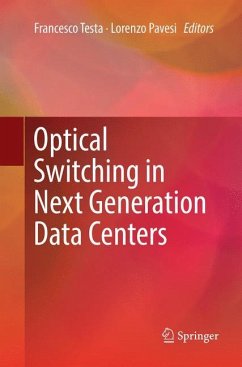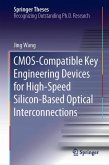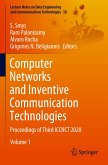Optical Switching in Next Generation Data Centers
Herausgegeben:Testa, Francesco; Pavesi, Lorenzo
Optical Switching in Next Generation Data Centers
Herausgegeben:Testa, Francesco; Pavesi, Lorenzo
- Broschiertes Buch
- Merkliste
- Auf die Merkliste
- Bewerten Bewerten
- Teilen
- Produkt teilen
- Produkterinnerung
- Produkterinnerung
This book introduces the reader to the optical switching technology for its application to data centers. In addition, it takes a picture of the status of the technology and system architecture evolution and of the research in the area of optical switching in data center. The book is organized in four parts: the first part is focused on the system aspects of optical switching in intra-data center networking, the second part is dedicated to describing the recently demonstrated optical switching networks, the third part deals with the latest technologies developed to enable optical switching and,…mehr
Andere Kunden interessierten sich auch für
![CMOS-Compatible Key Engineering Devices for High-Speed Silicon-Based Optical Interconnections CMOS-Compatible Key Engineering Devices for High-Speed Silicon-Based Optical Interconnections]() Jing WangCMOS-Compatible Key Engineering Devices for High-Speed Silicon-Based Optical Interconnections74,99 €
Jing WangCMOS-Compatible Key Engineering Devices for High-Speed Silicon-Based Optical Interconnections74,99 €![Photoptics 2015 Photoptics 2015]() Photoptics 2015110,99 €
Photoptics 2015110,99 €![Photonic Networks Photonic Networks]() Photonic Networks74,99 €
Photonic Networks74,99 €![Emerging Research in Electronics, Computer Science and Technology Emerging Research in Electronics, Computer Science and Technology]() Emerging Research in Electronics, Computer Science and Technology156,99 €
Emerging Research in Electronics, Computer Science and Technology156,99 €![Computer Networks and Inventive Communication Technologies Computer Networks and Inventive Communication Technologies]() Computer Networks and Inventive Communication Technologies154,99 €
Computer Networks and Inventive Communication Technologies154,99 €![Optical and Wireless Technologies Optical and Wireless Technologies]() Optical and Wireless Technologies147,99 €
Optical and Wireless Technologies147,99 €![VLSI, Microwave and Wireless Technologies VLSI, Microwave and Wireless Technologies]() VLSI, Microwave and Wireless Technologies147,99 €
VLSI, Microwave and Wireless Technologies147,99 €-
-
-
This book introduces the reader to the optical switching technology for its application to data centers. In addition, it takes a picture of the status of the technology and system architecture evolution and of the research in the area of optical switching in data center. The book is organized in four parts: the first part is focused on the system aspects of optical switching in intra-data center networking, the second part is dedicated to describing the recently demonstrated optical switching networks, the third part deals with the latest technologies developed to enable optical switching and, finally, the fourth part of the book outlines the future prospects and trends.
Produktdetails
- Produktdetails
- Verlag: Springer / Springer International Publishing / Springer, Berlin
- Artikelnr. des Verlages: 978-3-319-86992-6
- Softcover reprint of the original 1st ed. 2018
- Seitenzahl: 352
- Erscheinungstermin: 18. August 2018
- Englisch
- Abmessung: 235mm x 155mm x 20mm
- Gewicht: 539g
- ISBN-13: 9783319869926
- ISBN-10: 3319869922
- Artikelnr.: 55127306
- Verlag: Springer / Springer International Publishing / Springer, Berlin
- Artikelnr. des Verlages: 978-3-319-86992-6
- Softcover reprint of the original 1st ed. 2018
- Seitenzahl: 352
- Erscheinungstermin: 18. August 2018
- Englisch
- Abmessung: 235mm x 155mm x 20mm
- Gewicht: 539g
- ISBN-13: 9783319869926
- ISBN-10: 3319869922
- Artikelnr.: 55127306
Dr. Francesco Testa is Principal Researcher at Ericsson Research in Pisa. He received the Engineering degree , summa cum laude, from the University of Rome in 1980. In 1982 he received a scholarship from Fondazione Ugo Bordoni in Rome, for researching on integrated optics. He started working in 1985 at Alcatel-Face Italy on the research of coherent optical systems. He joined Ericsson in Rome in 1991, where he worked on the first demonstrations of WDM transport systems in the framework of the European projects RACE and ACTS. He was later involved in the hardware design and development of transmission and switching equipments for SDH, DECT, Local Multipoint Distribution System (LMDS), GSM and Access networks products. He is currently engaged in the research on optical systems and photonic integrated technologies for 5G and data center networks. He has co-authored many papers in the field of optical communications and he was invited speaker at ECOC 2015 conference in Valencia and at the SPIE Conference on Silicon Photonics and Photonic Integrated Circuits in Brussels in 2012. He holds more than 40 patents. He is the technical coordinator of the IRIS project in the FP7 European Union Framework Program. He has co-authored a chapter of the book Silicon Photonics III edited by Lorenzo Pavesi and David Lockwood, Topics in Applied Physics vol 122 (Springer-Verlag, 2016). Dr. Lorenzo Pavesi is a Professor of Experimental Physics, director of the Nanoscience Laboratory and head of the Department of Physics at the University of Trento. He received his PhD in Physics in 1990 at the Ecole Polytechnique Federale of Lausanne). He founded the research activity in semiconductor optoelectronics at the University of Trento and started several laboratories of photonics, growth and advanced treatment of materials. He was the first president and founder of the IEEE italian chapter on Nanotechnology. His interests encompass classical and quantum integrated silicon photonics. He is a frequently invited reviewer, monitor or referee for photonics projects by several grant agencies. He is an author or co-author of more than 400 papers, author of several reviews, editor of more than 20 books (including the successful books Silicon Photonics I,II,III, Topics in Applied Physics, Springer-Verlag), author of 2 books and holds 7 patents. He is chief specialty editor of the section Optics and Photonics of Frontiers in Materials, and in the editorial board of APL Materials and Research Letters in Physics.. In 2010 and 2011 he was elected distinguished speaker of the IEEE- Photonics society. He is a fellow of IEEE and senior member of SPIE. He holds an H-number of 53 according to the web of science and of 64 according to Google Scholar.
Part 1. System aspects of intra data center networking.- Chapter 1.Photonics Data Centers.- Chapter 2.Optical switching in Data Centers Architectures based on optical circuit switching.- Chapter 3.Optical switching in Data Centers: Architectures based on optical packet/burst switching.- Part 2. Demonstrations of optical switching in Data Center.- Chapter 4.OSA an Optical Switching Architecture for Data Center Networks with Unprecendented Flexibility.- Chapter 5. The Hi-Ring Architecture for Data Center Networks.- Chapter 6.Low Latency Interconnect Optical Network Switch (LIONS).- Chapter 7. Torus-Topology Data Center Networks with Hybrid Opto-electronic Routers.- Chapter 8.LIGHTNESS: All-Optical SDN-enabled Intra-DCN with Optical Circuit and Packet Switching.- Chapter 9.Hybrid OPS/EPS Photonic Ethernet Switch and Pure Photonic Packet Switch.- Chapter 10. OPMDC: Optical Pyramid Data Center Network.- Part 3. Technologies for Optical Switching in Data Centers.- Chapter 11.Commercial optical switches.- Chapter 12.Silicon Photonics switch Matrices: Technologies and Architectures.- Chapter 13.Trends in High Speed Interconnects for Datacenter Networking: Multidimensional Formats and Their Enabling DSP.- Chapter 14.Trends in high speed interconnects for data center networking : InP monolithic integration.- Part 4. Prospects and future trends._Chapter 15. The future of switching in data centers.
Part 1. System aspects of intra data center networking.- Chapter 1.Photonics Data Centers.- Chapter 2.Optical switching in Data Centers Architectures based on optical circuit switching.- Chapter 3.Optical switching in Data Centers: Architectures based on optical packet/burst switching.- Part 2. Demonstrations of optical switching in Data Center.- Chapter 4.OSA an Optical Switching Architecture for Data Center Networks with Unprecendented Flexibility.- Chapter 5. The Hi-Ring Architecture for Data Center Networks.- Chapter 6.Low Latency Interconnect Optical Network Switch (LIONS).- Chapter 7. Torus-Topology Data Center Networks with Hybrid Opto-electronic Routers.- Chapter 8.LIGHTNESS: All-Optical SDN-enabled Intra-DCN with Optical Circuit and Packet Switching.- Chapter 9.Hybrid OPS/EPS Photonic Ethernet Switch and Pure Photonic Packet Switch.- Chapter 10. OPMDC: Optical Pyramid Data Center Network.- Part 3. Technologies for Optical Switching in Data Centers.- Chapter 11.Commercial optical switches.- Chapter 12.Silicon Photonics switch Matrices: Technologies and Architectures.- Chapter 13.Trends in High Speed Interconnects for Datacenter Networking: Multidimensional Formats and Their Enabling DSP.- Chapter 14.Trends in high speed interconnects for data center networking : InP monolithic integration.- Part 4. Prospects and future trends._Chapter 15. The future of switching in data centers.








